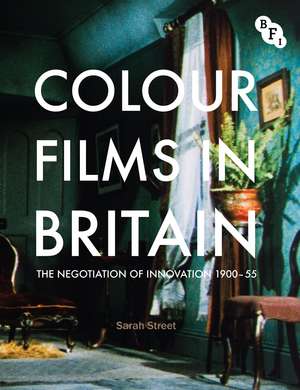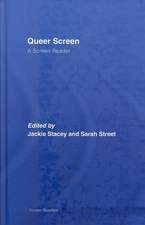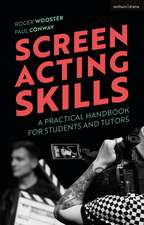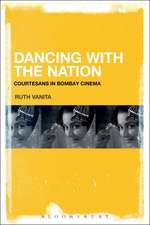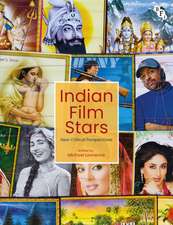Colour Films in Britain: The Negotiation of Innovation 1900-1955
Autor Sarah Streeten Limba Engleză Paperback – 17 oct 2012
| Toate formatele și edițiile | Preț | Express |
|---|---|---|
| Paperback (1) | 239.51 lei 3-5 săpt. | |
| Bloomsbury Publishing – 17 oct 2012 | 239.51 lei 3-5 săpt. | |
| Hardback (1) | 605.37 lei 3-5 săpt. | |
| Bloomsbury Publishing – 18 oct 2012 | 605.37 lei 3-5 săpt. |
Preț: 239.51 lei
Nou
Puncte Express: 359
Preț estimativ în valută:
45.84€ • 47.68$ • 37.84£
45.84€ • 47.68$ • 37.84£
Carte disponibilă
Livrare economică 24 martie-07 aprilie
Preluare comenzi: 021 569.72.76
Specificații
ISBN-13: 9781844573127
ISBN-10: 1844573125
Pagini: 320
Ilustrații: 164 colour photos
Dimensiuni: 155 x 235 x 25 mm
Greutate: 0.78 kg
Ediția:2012
Editura: Bloomsbury Publishing
Colecția British Film Institute
Locul publicării:London, United Kingdom
ISBN-10: 1844573125
Pagini: 320
Ilustrații: 164 colour photos
Dimensiuni: 155 x 235 x 25 mm
Greutate: 0.78 kg
Ediția:2012
Editura: Bloomsbury Publishing
Colecția British Film Institute
Locul publicării:London, United Kingdom
Caracteristici
Includes detailed analysis of individual colour films e.g. Powell and Pressburger's Black Narcissus (1947) and FrieseGreene's The Open Road (192
Notă biografică
SARAH STREET is Professor of Film at the University of Bristol. Her publications include Cinema and State: The Film Industry and the British Government, 1927-84 (co-authored with Margaret Dickinson, 1985); British National Cinema (1997, 2nd edition 2009); British Cinema in Documents (2000); Transatlantic Crossings: British Feature Films in the USA (2002); Black Narcissus (2005), and Film Architecture and the Transnational Imagination: Set Design in 1930s European Cinema (coauthored with Tim Bergfelder and Sue Harris, 2007). She is a member of the editorial boards of the Journal of British Cinema and Television and of Screen. Technical appendix by Simon Brown: SIMON BROWN is Director of Studies for Film and Television at Kingston University, UK. A historian and former film archivist, he has published widely on early and British cinema, including pieces on British colour films in the 1920s and in the 1930s, with a particular focus on Dufaycolor. Alongside Sarah Street and Liz Watkins, he is also co-editor of the forthcoming book Colour and the Moving Image: History, Theory, Aesthetics, Archive (New York, Routledge, 2012).
Cuprins
Acknowledgements.- Introduction.- Colour and Silent Cinema.- Colour and Sound Cinema.- Genre: Colour, Fantasy and Realism.- Questions of Aesthetics: Image, Sound, Colour.- Colour and the Audience: Stars, Gender, Colour and Society.- Creating Colour in British Cinema: Questions of Authorship and Aesthetics.- Technical Appendix; S.Brown.- Notes.- Bibliography.- Index.
Recenzii
In addition to the quality of the research, the book is also beautifully-designed. It features numerous colour illustrations - primarily frame enlargements - which are very helpful in comprehending Street's many detailed analyses of individual films. The book also features two appendices that enhance its value as a reference work: a list of the colour films distributed in Britain between 1938 and 1955 (based on Kinematograph Weekly), and a concise and very useful description of the colour film processes and technologies discussed in the book (compiled by Simon Brown). Colour Films in Britain succeeds both as a comprehensive national film history and as a reflection on colour in cinema, and will be a valuable and lasting contribution to the field of film studies.
Sarah Street's groundbreaking study is that rare film history text which is at once absolutely authoritative, and pitched at a very high level in terms of discourse, but still readily accessible to the general reader. In addition, the volume is richly - and I mean intensely - illustrated with numerous, exquisitely printed frame blowups from the many films it examines, all in full color, and Street's analysis of the development of color, not only in the commercial British cinema, but also in the the experimental work of artists such as Len Lye, is meticulous and detailed.
Sarah Street's groundbreaking study is that rare film history text which is at once absolutely authoritative, and pitched at a very high level in terms of discourse, but still readily accessible to the general reader. In addition, the volume is richly - and I mean intensely - illustrated with numerous, exquisitely printed frame blowups from the many films it examines, all in full color, and Street's analysis of the development of color, not only in the commercial British cinema, but also in the the experimental work of artists such as Len Lye, is meticulous and detailed.
